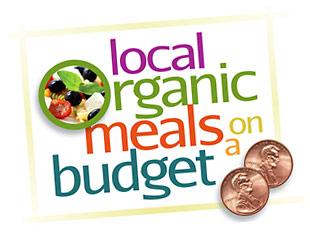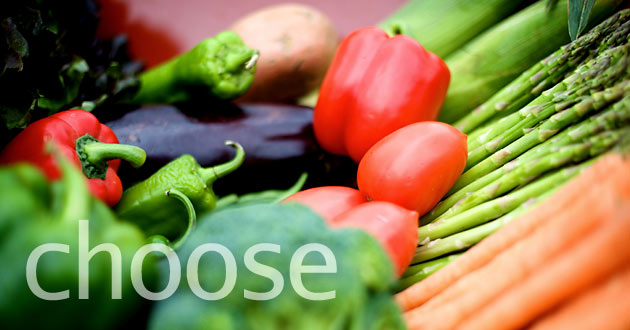Why choose local and organic foods?
Buying and eating local and organic foods brings lots of benefits to you, your family, your community and the planet. Here are some of the most compelling reasons to choose local and organic:
- What is organic?
- 10 reasons to choose organic
- Why eat organic and local foods?
- What are GMOs (Genetically Modified Organisms)?
- What is the true cost of food?
What is organic?
Organic ingredients are grown without the use of synthetic pesticides, herbicides, or fertilizers and do not contain genetically modified or other artificial ingredients. Organic meat and dairy come from animals that eat organic feed and are not given growth hormones or antibiotics.
10 reasons to choose organic
1. ORGANIC PRODUCTS MEET STRINGENT STANDARDS
Organic certification is the public’s assurance that products have been grown and handled according to strict procedures without persistent toxic chemical inputs.
2. ORGANIC FOOD TASTES GREAT!
It’s common sense—well-balanced soils produce strong, healthy plants that become nourishing food for people and animals.
3. ORGANIC PRODUCTION REDUCES HEALTH RISKS
Many EPA-approved pesticides were registered long before extensive research linked these chemicals to cancer and other diseases. Organic agriculture is one way to prevent any more of these chemicals from getting into the air, earth, and water that sustain us.
4. ORGANIC FARMS RESPECT OUR WATER RESOURCES
The elimination of polluting chemicals and nitrogen leaching, done in combination with soil building, protects and conserves water resources.
5. ORGANIC FARMERS BUILD HEALTHY SOIL
Soil is the foundation of the food chain. The primary focus of organic farming is to use practices that build healthy soils.
6. ORGANIC FARMERS WORK IN HARMONY WITH NATURE
Organic agriculture respects the balance demanded of a healthy ecosystem: wildlife is encouraged by including forage crops in rotation and by retaining fence rows, wetlands, and other natural areas.
7. ORGANIC PRODUCERS ARE LEADERS IN INNOVATIVE RESEARCH
Organic farmers have led the way, largely at their own expense, with innovative on-farm research aimed at reducing pesticide use and minimizing agriculture’s impact on the environment.
8. ORGANIC PRODUCERS STRIVE TO PRESERVE DIVERSITY
The loss of a large variety of species (biodiversity) is one of the most pressing environmental concerns. The good news is that many organic farmers and gardeners have been collecting and preserving seeds and growing unusual varieties for decades.
9. ORGANIC FARMING HELPS KEEP RURAL COMMUNITIES HEALTHY
USDA reported that in 1997, half of U.S. farm production came from only 2% of farms. Organic agriculture can be a lifeline for small farms because it offers an alternative market where sellers can command fair prices for crops.
10. ORGANIC ABUNDANCE—FOODS AND NON-FOODS ALIKE!
Now every food category has an organic alternative. And non-food agricultural products are being grown organically – even cotton, which most experts felt could not be grown this way.
- Organic Trade Association • www.ota.com
Why eat local & organic foods?
From the Mayo Clinic: www.mayoclinic.com
Learn the basics: wikipedia.org/wiki/Organic_food
The Truth About Organic Foods: www.redbookmag.com
The dirty dozen and clean 15 of produce: Pesticides and cancer risk www.pbs.org
Local and Organic Food and Farming: The Gold Standard: www.organicconsumers.org/articles/article_22627.cfm
Local vs. Organic Produce: Which is Better?: www.simpleorganic.net
Organic vs. Conventional Farming Practices: http://www.education.com
Shoppers Guide To Pesticides: http://www.foodnews.org/faq.php
What are "GMOs" (Genetically Modified Organisms) and why should I care?
GMOs, or “genetically modified organisms,” are plants or animals created by biotechnology that merges DNA from different species, creating unstable combinations of plant, animal, bacterial and viral genes that cannot occur in nature or in traditional crossbreeding.
The effect of GMO foods on the human body have not been tested enough to prove that they are safe for human consumption. Serious health risks have been associated with the consumption of genetically modified foods, including organ failure. In addition to human health problems, the production of GMO cash crops poses huge implications to the environment, as well as the rights and wellbeing of traditional farmers.
The following lists “high risk” produce in which GMOs constitute a majority of production.
- Alfalfa (first planting 2011)
- Canola (approx. 90% of U.S. crop)
- Corn (approx. 88% of U.S. crop in 2011)
- Cotton (approx. 90% of U.S. crop in 2011)
- Papaya (most of Hawaiian crop; approximately 988 acres)
- Soy (approx. 94% of U.S. crop in 2011)
- Sugar Beets (approx. 95% of U.S. crop in 2010)
- Zucchini and Yellow Summer Squash (approx. 25,000 acres)
There can be GMOs in foods we would not otherwise consider to contain them, because of their ingredients. Some examples of these are: Amino Acids, Aspartame, Ascorbic Acid, Sodium Ascorbate, Vitamin C, Citric Acid, Sodium Citrate, Ethanol, Flavorings (“natural” and “artificial”), High-Fructose Corn Syrup, Hydrolyzed Vegetable Protein, Lactic Acid, Maltodextrins, Molasses, Monosodium Glutamate, Sucrose, Textured Vegetable Protein (TVP), Xanthan Gum, Vitamins, Yeast Products.
Look for food with the Non GMO Project label to avoid eating GMOs. Learn more at their website: www.nongmoproject.org
Here is some information on commonly consumed produce:
• Tomatoes: In 1994, genetically modified Flavr Savr tomatoes became the first commercially produced GMOs. They were brought out of production just a few years later, in 1997, due to problems with flavor and ability to hold up in shipping. There are no genetically engineered tomatoes in commercial production, and tomatoes are considered “low-risk” by the Non-GMO Project Standard.
• Potatoes: Genetically modified NewLeaf potatoes were introduced by Monsanto in 1996. Due to consumer rejection several fast-food chains and chip makers, the product was never successful and was discontinued in the spring of 2001. There are no genetically engineered potatoes in commercial production, and potatoes are considered “low-risk” by the Non-GMO Project Standard.
• Wheat: There is not currently, nor has there ever been, any genetically engineered wheat on the market. Of all “low-risk” crops, this is the one most commonly (and incorrectly) assumed to be GMO. It is a key commodity crop, and the biotech industry is pushing hard to bring GMO varieties to market. The Non-GMO Project closely watches all development on this front.
• Salmon: A company called AquaBounty is currently petitioning the FDA to approve its genetically engineered variety of salmon, which has met with fierce consumer resistance. Find out more here.
• Pigs: A genetically engineered variety of pig, called Enviropig was developed by scientists at the University of Guelph, with research starting in 1995 and government approval sought beginning in 2009. In 2012 the University announced an end to the Enviropig program, and the pigs themselves were euthanized in June 2012.
Statistics and information from www.nongmoproject.org
Explore Further
Learn the basics: www.responsibletechnology.org/gmo-basics
What is the true cost of food?
"We are the food we eat, the water we drink, the air we breathe. And reclaiming the democratic control over our food and water and our ecological survival is the necessary project for our freedom." – Vandana Shiva, physicist and activist
One of the main concerns with local organic food is always the cost. It’s easy to see the difference on the price tag when we shop at the farmers’ market and buy something labeled organic. But what about beyond the price tag? What factors skew our consumer perception of the “price” of produce?
There are a few reasons why organic costs more at face value and why conventionally grown food has far more costs under the surface:
Subsidies/Economics
Between 1995 and 2011, $18.2 billion in tax dollars subsidized four common food additives - corn syrup, high fructose corn syrup, corn starch, and soy oils (known as hydrogenated vegetable oils).
Organic farmers don’t receive federal subsidies like conventional farmers do. Therefore, the price of organic food reflects the true cost of growing. Organic farming is more labor and management intensive.
Organic farms are usually smaller than conventional farms and so do not benefit from the economies of scale that larger growers get.
Environmental costs
The price of conventional food does not reflect the cost of environmental cleanups that we pay for through our tax dollars.
Conventionally grown food degrades arable land and the healthy soil needed for biological diversity. Water scarcity is a huge issue and when the nutrients are leached out of the soil and not replaced, it leads to more runoff and less water conservation.
Health Costs
93% of Americans tested by the CDC had metabolites of chlorpyrifos, a nuerotoxic insectide, in their urine. Banned from home use because of its risks to children, chlorpyrifos is part of a family of pesticides (organophosphates) linked to ADHD. Also, 99% of Americans tested positive for DDT degradants, even though DDT hasn't been used in the U.S. since 1972. Women who were exposed to DDT as girls are 5 times more likely to develop breast cancer. Pesticides have negative effects not only on humans, but also bees and other pollinators that are imperative to growing food.
Explore Further
Getting Real About the High Price of Cheap Food: www.time.com
The True Cost of Food: www.chow.com
Organic food is cheaper than conventional food: http://current.com/news
Comparing Taxpayer Subsidies for Fresh Produce and Junk: www.uspirg.org
All about organic: www.organic.org
Pesticides, Pesticide Exposure & Your Health: www.panna.org/your-health/food
Are Farmers' Markets a More Expensive Way to Shop?
www.farmersmarketsnm.org
Folks who don’t regularly shop at farmers’ markets often wonder how the pricing compares to what they typically find at the grocery store. Though prices at farmers’ markets can vary greatly across the state (tomatoes, for example, may range anywhere from 50 cents to $4 per pound depending on location and time of year), shoppers sometimes find that prices can be a little higher than those at the big supermarkets like Walmart or Smiths.
It’s not a simple comparison, however.
Small-scale farmers who sell at local farmers’ and growers’ markets price their produce based on the true cost of growing the food. Farmers of commercial commodity crops, on the other hand, receive large subsidies from the government and rely on cheap oil for transportation as well as cheap labor for production. Consumers may not be paying the full price of commercial produce at the checkout counter, but they do eventually pay for it come tax time.
In addition to paying fair labor and transportation costs, local growers tend to avoid the cheap chemicals of commercial agriculture, opting instead for organic solutions and more intensive labor when it comes to problems like pests, weeds, and diseases. These approaches that work in tune with nature, rather than against it, tend to cost more.
Beyond the policy and production cost reasons for the price discrepancy, consumers can also consider the quality of the produce they buy. Anyone who has ever raised a garden or bought a tomato from a local grower can tell you that there is simply no comparison to what you get at the supermarket. Produce sold in supermarkets has been picked before it’s ripe so that it can last during transportation. According to the Worldwatch Institute, American food travels an average distance of 1,500 to 2,000 miles from farm to fork. Not only does picking produce too early reduce the amount of nutrients in the food, but it also reduces the flavor. Fully ripe fruits and vegetables that have been picked anywhere from a couple hours to a couple days before you eat them teach you what real food tastes like.
Farmers’ markets are a great way to eat in a way that’s good for our local economy, our health, our environment, and our tastebuds. Whether you use your SNAP card, your WIC or Senior benefits, your debit card, or plain old cash, spending food dollars at farmers’ markets is a way to show that you care about where your food comes from and the future of real food.
Why buy from your local Farmers Market? (PDF)





